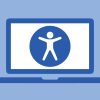Digital Accessibility Policy
To uphold our commitment to creating a diverse, inclusive and supportive atmosphere for everyone, UW–Madison authorized the Digital Accessibility Policy to align with UW–Madison and Universities of Wisconsin policies that protect people with disabilities against discrimination and honors our institutional statement on diversity. The policy does this through raising awareness of digital accessibility best practices, guiding the university toward designing and purchasing accessible technology, and establishing a network of digital accessibility liaisons who will share accessibility best practices with their local units.
Find essential guidance on meeting UW–Madison’s Digital Accessibility Policy, from understanding accessibility’s importance to compliance steps, accessible technology procurement, and available campus resources in our guide, How to follow UW–Madison’s Digital Accessibility Policy.
Make it Accessible
Learn about many areas of digital accessibility, from web development and document creation to purchasing technology in our Make it Accessible guides.
Focusing on accessibility from the start creates digital experiences that more people can use, including people with disabilities.
Purchasing accessible technology
Our guide for purchasing accessible technology shares resources for considering digital accessibility during procurement, including language for requests for proposals (RFP) and contracts, as well as support offered by the Center for User Experience.
Digital accessibility liaisons
The digital accessibility liaison network is coordinated and supported by the Center for User Experience, the Americans with Disabilities Act (ADA) Coordinator, and other university partners. Your liaison will help with policy questions and resources for your unit. Use the liaison directory to find your liaison’s contact information.
Current focus: websites and course materials
As we work toward our goal to make UW–Madison’s digital landscape accessible and welcoming, we’ve strategized around different content types and focus areas to learn best practices for creating and maintaining those digital resources. The current focus areas of the policy are websites, web applications, and course materials. Course material accessibility includes, but is not limited to, courses created in Canvas, learning tools integrated within Canvas, and documents. We encourage units to prioritize their digital resources to determine where they should focus resources to support the policy.
Website and web app accessibility
Guidance for developers and content creators to design in conformance with web accessibility guidelines.
Testing web accessibility
Use this guide get started with testing interactive websites and web applications for accessibility and assistive technology support.
Testing document accessibility
Use this guide to learn how to check Microsoft Word and PowerPoint, Google Docs and Slides, and PDF documents for accessibility using each platform’s built-in accessibility checkers.
Document accessibility
Follow these steps to increase the accessibility of your Word, PowerPoint, Google Docs and Slides, PDF, and Adobe InDesign documents.
Course material accessibility
Use this guide to improve the accessibility of your Canvas course content, including documents.
Digital accessibility news
List of articles

Social media for all of us: Making content accessible & inclusive
Watch June's session for insights on best practices for social media design—and why making your sites more accessible benefits every part of your work.
June 11, 2025
Accessibility in action: spring events & resources
Creating accessible digital experiences requires a shared commitment. Design for usability, refine your processes and put best practices into action to create more inclusive, accessible experiences online.
February 19, 2025
UW–Madison prepares for compliance with new federal rule on digital accessibility
Universities must make digital resources accessible by Apr 24, 2026, under a new Justice Department rule. Learn about the committee tasked with identifying barriers and resources needed for compliance.
November 6, 2024
Accessibility with UDOIT: Text styling in Canvas
UDOIT is a tool that helps instructors fix digital accessibility barriers directly within Canvas. Learn more about how screen readers interpret text styling, and how to make your course better for students who use them.
July 26, 2024
Digital Accessibility Policy: implementation plan roadmap
The Digital Accessibility Policy aligns with UW–Madison and Universities of Wisconsin policies that protect people with disabilities against discrimination and honors our institutional statement on diversity. This roadmap tracks the implementation of the new policy over the life of the project.
July 2, 2024- More Digital Accessibility posts
FAQs
This is an accordion element with a series of buttons that open and close related content panels.
What is the timeline for implementation?
The implementation plan for this policy is phased to focus on a few digital resource categories at a time. With this plan, we can prioritize and make progress as a community toward a more accessible digital university. These phases are not meant to dictate what work occurs, but rather place a proactive focus for accessibility work during these time frames and when CUE will provide targeted support. If a person experiences a barrier in any of these content types, that work should be prioritized and not limited for completion by the phases.
| Phase | Effective date |
|---|---|
| Policy effective, liaison network established | July 1, 2023 |
| Documents | 2023 – 2024 |
| Websites, web apps, LMS/LTI, multimedia | 2024 – 2026 |
How do I know if we’re in compliance with the policy?
Being in compliance with the policy means:
- The university adheres to legal and regulatory requirements.
- Your school, college, unit or division has assigned a digital accessibility liaison.
- Following through when a barrier is reported or discovered in your school, college, unit or division, by remediating the barrier or completing an Equally Effective Alternate Access Plan (EEAAP). An EEAAP details how the benefits or services offered by the digital tool will be made available to individuals with disabilities until conformance with the policy can be met. This may require consultation with the Center for User Experience and the ADA coordinator.
While timely accommodations must be provided when an accessibility barrier cannot readily be addressed, solely providing accommodations does not meet the requirements of this policy.
How do I know my technology, or other technologies are accessible?
The Center for User Experience evaluates digital tools and resources in use or under consideration for purchase as resources allow to create university-level documentation about any barriers that might be present.
You can review the IT Accessibility and Usability KnowledgeBase to see if there are any known barriers and contact the Center for User Experience for a consultation if your product isn’t listed.
University partners in accessibility
Center for User Experience
The Center for User Experience partners with you to create more accessible, usable and inclusive digital spaces for all students, faculty and staff.
Digital Accessibility Liaison Network
Digital accessibility liaisons partner with the Center for User Experience to advocate for accessibility within their units and serve as their unit’s primary point of contact for learning more about digital accessibility.
Digital Accessibility Community of Practice (CoP)
The Digital Accessibility CoP promotes inclusive digital experiences and content across our campus community.
Americans with Disabilities Act (ADA) Coordinator, Office of Compliance
The Office of Compliance advances compliance with applicable laws and policies at UW–Madison. The Americans with Disabilities Act (ADA) provides that no qualified individual with a disability be denied access to or participation in services, programs, and activities at the University of Wisconsin–Madison.
McBurney Disability Resource Center
The McBurney Disability Resource Center is the office for students with disabilities and classroom accommodations on the UW–Madison campus.
Employee Disability Resource Office (EDR)
The EDR serves as the campus wide hub for information on the disability accommodation process for employees and applicants.
For more information about university resources and accessibility support, visit accessible.wisc.edu.
How to get help
If you are looking for more information about the Digital Accessibility Policy or evaluation and consultation services, get in touch with the Center for User Experience.
Get in touch
- Meet with us: Book a quick chat with one of our team members to ask any questions you have.
- Start a project with us: We support accessible design and development. Fill out our Let’s Connect form to begin working with us on your project or to request an accessibility evaluation.
- Email us: Not sure if you’re ready to meet? Email us to start talking and figure out what to do next.



